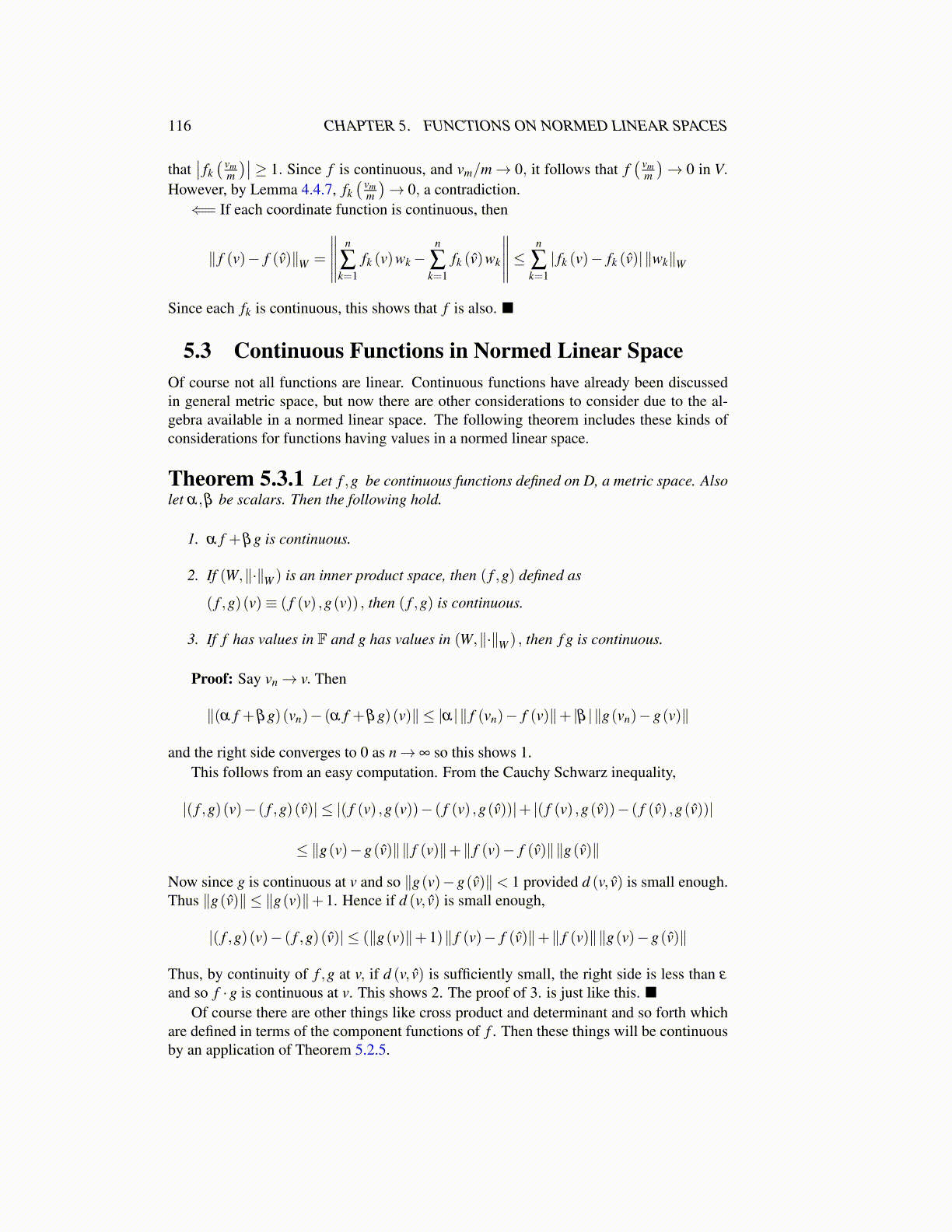
116 CHAPTER 5. FUNCTIONS ON NORMED LINEAR SPACES
that∣∣ fk( vm
m
)∣∣ ≥ 1. Since f is continuous, and vm/m→ 0, it follows that f( vm
m
)→ 0 in V.
However, by Lemma 4.4.7, fk( vm
m
)→ 0, a contradiction.
⇐= If each coordinate function is continuous, then
∥ f (v)− f (v̂)∥W =
∥∥∥∥∥ n
∑k=1
fk (v)wk−n
∑k=1
fk (v̂)wk
∥∥∥∥∥≤ n
∑k=1| fk (v)− fk (v̂)|∥wk∥W
Since each fk is continuous, this shows that f is also. ■
5.3 Continuous Functions in Normed Linear SpaceOf course not all functions are linear. Continuous functions have already been discussedin general metric space, but now there are other considerations to consider due to the al-gebra available in a normed linear space. The following theorem includes these kinds ofconsiderations for functions having values in a normed linear space.
Theorem 5.3.1 Let f ,g be continuous functions defined on D, a metric space. Alsolet α,β be scalars. Then the following hold.
1. α f +βg is continuous.
2. If (W,∥·∥W ) is an inner product space, then ( f ,g) defined as
( f ,g)(v)≡ ( f (v) ,g(v)) , then ( f ,g) is continuous.
3. If f has values in F and g has values in (W,∥·∥W ) , then f g is continuous.
Proof: Say vn→ v. Then
∥(α f +βg)(vn)− (α f +βg)(v)∥ ≤ |α|∥ f (vn)− f (v)∥+ |β |∥g(vn)−g(v)∥
and the right side converges to 0 as n→ ∞ so this shows 1.This follows from an easy computation. From the Cauchy Schwarz inequality,
|( f ,g)(v)− ( f ,g)(v̂)| ≤ |( f (v) ,g(v))− ( f (v) ,g(v̂))|+ |( f (v) ,g(v̂))− ( f (v̂) ,g(v̂))|
≤ ∥g(v)−g(v̂)∥∥ f (v)∥+∥ f (v)− f (v̂)∥∥g(v̂)∥
Now since g is continuous at v and so ∥g(v)−g(v̂)∥< 1 provided d (v, v̂) is small enough.Thus ∥g(v̂)∥ ≤ ∥g(v)∥+1. Hence if d (v, v̂) is small enough,
|( f ,g)(v)− ( f ,g)(v̂)| ≤ (∥g(v)∥+1)∥ f (v)− f (v̂)∥+∥ f (v)∥∥g(v)−g(v̂)∥
Thus, by continuity of f ,g at v, if d (v, v̂) is sufficiently small, the right side is less than ε
and so f ·g is continuous at v. This shows 2. The proof of 3. is just like this. ■Of course there are other things like cross product and determinant and so forth which
are defined in terms of the component functions of f . Then these things will be continuousby an application of Theorem 5.2.5.